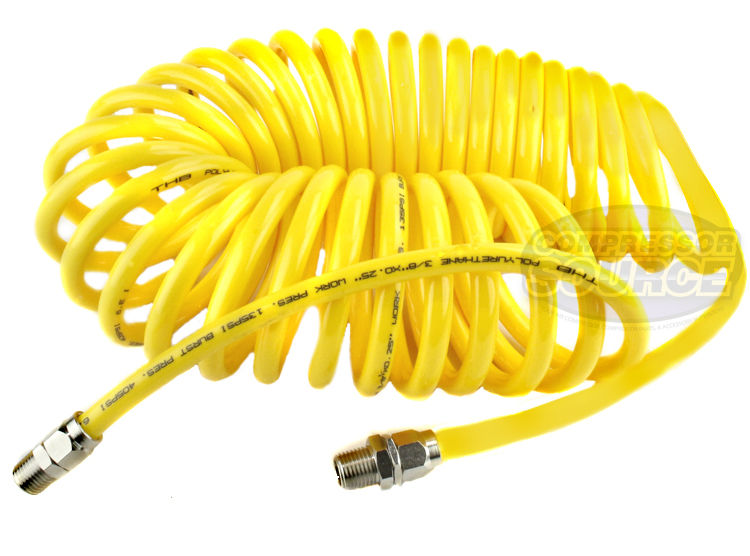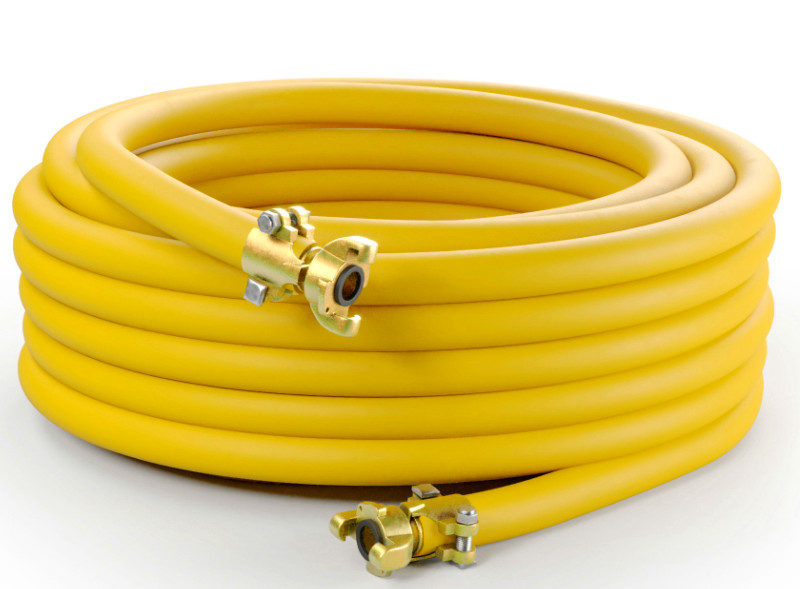If you use an air compressor, you know how important the right hose is for getting the job done smoothly. But with so many options out there, how do you choose the best air compressor hose for your needs?
The right hose can make your work faster, safer, and more efficient. You’ll discover what to look for, how to avoid common mistakes, and tips to keep your hose lasting longer. Keep reading to make sure your air compressor setup works perfectly every time.
Types Of Air Compressor Hoses
Air compressor hoses come in different types to suit various tasks. Choosing the right hose helps improve tool performance and safety. Each type has unique features for specific needs.
Pvc Hoses
PVC hoses are lightweight and easy to handle. They resist chemicals and abrasion. These hoses work well for light to medium jobs. They stay flexible in warm temperatures but can stiffen in cold weather. PVC hoses are affordable and popular for general use.
Rubber Hoses
Rubber hoses offer excellent durability and flexibility. They handle high pressure and rough surfaces well. These hoses resist heat and weather changes. Rubber hoses are heavier but last longer. They suit heavy-duty air compressor tasks.
Hybrid Hoses
Hybrid hoses combine the best of rubber and PVC. They are light yet strong and flexible. These hoses resist kinks and wear. Hybrid hoses work well in tough environments. They balance durability and ease of use.
Thermoplastic Hoses
Thermoplastic hoses are tough and flexible. They resist UV rays and chemicals. These hoses stay soft even in cold weather. Thermoplastic hoses are easy to clean and long-lasting. They fit well for professional and industrial jobs.
Materials And Construction
Air compressor hoses must be strong and flexible to work well. Their materials and construction affect their durability and safety. Good hoses last longer and handle pressure better.
Inner Tube Composition
The inner tube carries air from the compressor. It needs to resist heat, oil, and chemicals. Common materials include rubber, PVC, and polyurethane. Rubber offers good heat and abrasion resistance. PVC is lightweight and cost-effective. Polyurethane is flexible and resists kinks. The choice depends on the air tool and environment.
Reinforcement Layers
Reinforcement layers add strength and prevent hose bursting. They often use braided polyester or steel wire. Polyester reinforcement keeps hoses light and flexible. Steel wire is for heavy-duty and high-pressure hoses. These layers help the hose maintain shape and handle tough jobs.
Outer Cover Features
The outer cover protects the hose from cuts, abrasion, and weather. It is usually made from rubber or PVC. Rubber covers resist oil and rough surfaces well. PVC covers handle sunlight and water better. The cover also improves grip and safety during work.
Key Factors Affecting Durability
Durability is key when choosing an air compressor hose. A strong hose lasts longer and works better. Several factors affect how well a hose holds up over time. Understanding these helps in picking the right hose.
Resistance To Abrasion
A hose must resist wear from rubbing and scraping. High abrasion resistance stops cracks and holes. This keeps air pressure steady and prevents leaks. Look for hoses with tough outer layers for longer life.
Temperature Tolerance
Hoses face hot and cold conditions. Good temperature tolerance means the hose won’t crack or soften. It works well in cold winters and hot summers. Choose hoses made from materials that handle wide temperature ranges.
Chemical Compatibility
Air hoses may contact oils, fuels, or chemicals. Some materials break down when exposed to these. Chemical compatibility ensures the hose stays strong and safe. Check the hose’s material matches the chemicals it will meet.
Pressure Ratings
Every hose has a maximum pressure it can hold. Using a hose with the right pressure rating avoids bursts. It keeps the air flowing smoothly and safely. Always select a hose with a pressure rating above your compressor’s output.
Performance Considerations
Choosing the right air compressor hose can affect how well your tools work. Performance matters a lot. Understanding key factors helps you pick the best hose for your needs. Focus on flexibility, weight, kink resistance, and size. These features impact your work speed and tool efficiency.
Flexibility And Weight
Flexible hoses bend easily without breaking. This helps you move freely during work. Lightweight hoses reduce fatigue. Carrying a heavy hose can slow you down. Look for hoses that balance flexibility and light weight. They make tasks smoother and faster.
Kink Resistance
Kinking stops air flow and damages hoses. Some hoses resist kinks better. Materials like rubber or hybrid blends work well. Kink resistance keeps air flowing smoothly. It also extends hose life. Choose a hose that stays open under pressure and movement.
Length And Diameter Impact
Hose length affects reach and air pressure. Longer hoses reach distant tools but can lose pressure. Diameter controls how much air flows through. Wider hoses carry more air but are heavier. Pick length and diameter based on your tool needs and workspace size.
Flow Rate Efficiency
Flow rate shows how much air passes through the hose. High flow rates keep tools running strong. Hose size and material affect flow rate. A good hose delivers steady air without leaks. This saves energy and improves tool performance.
Maintenance Tips For Longevity
Proper care extends the life of air compressor hoses. Small steps keep hoses safe and working well. These tips help avoid costly replacements and keep air flowing strong.
Proper Storage Practices
Store hoses in a dry place away from sunlight. Avoid sharp bends or kinks during storage. Coil hoses loosely to prevent stress on the material. Hang hoses on hooks or reels to keep them off the ground. Keep hoses clean before storing to avoid dirt buildup.
Regular Inspection
Check hoses often for cracks, holes, or leaks. Look for wear spots and weak areas. Test connections to ensure tight seals. Replace damaged parts immediately to prevent failure. Regular checks catch problems early and keep hoses safe.
Cleaning Methods
Wipe hoses with a damp cloth to remove dirt. Use mild soap and water for stubborn grime. Avoid harsh chemicals that can damage the hose material. Rinse thoroughly and dry before storing. Clean hoses work better and last longer.
Avoiding Common Damage
Do not pull hoses by the fitting or connectors. Avoid dragging hoses over sharp or rough surfaces. Keep hoses away from hot surfaces or chemicals. Do not stretch hoses beyond their limit. Careful use prevents tears and weak spots.

Credit: compressor-source.com
Choosing The Right Hose For Your Needs
Choosing the right air compressor hose is key for efficient and safe work. The right hose ensures smooth air flow, durability, and safety. It also prevents leaks and damage to tools. Every job needs a hose that fits specific needs.
Matching Hose To Compressor Type
Select a hose that matches your compressor’s pressure and output. High-pressure compressors need hoses rated for that pressure. Small compressors work well with lightweight hoses. Check the hose diameter to fit the compressor’s output. Proper matching avoids air loss and damage.
Work Environment Factors
Consider the conditions where you use the hose. Outdoor work may need hoses that resist weather and sunlight. Indoor use might require flexible hoses for tight spaces. If the area is rough, pick a hose with strong outer material. Temperature changes also affect hose choice.
Budget Vs. Quality
Cheaper hoses save money but may wear out fast. Quality hoses last longer and reduce repair costs. Think about how often you use the hose. Frequent use justifies spending more on durability. Balance cost and performance to get the best value.
Safety Standards Compliance
Choose hoses that meet safety standards for air compressors. Look for certifications from recognized bodies. Proper safety compliance lowers risks of accidents and injuries. Always check the hose’s pressure rating and material quality. Safety is crucial for all air compressor work.
Common Issues And Troubleshooting
Air compressor hoses face many common problems during use. These issues can reduce performance and cause delays. Knowing how to spot and fix these problems saves time and money. This section covers simple ways to find leaks, handle hose wear, and decide between repair or replacement.
Leak Detection
Leaks reduce air pressure and waste energy. Finding leaks early keeps tools working well. Listen for hissing sounds near the hose. Use soapy water on hose joints and watch for bubbles. Mark leaks clearly to fix or replace damaged parts quickly.
Handling Hose Wear
Hoses wear out from bending, dragging, and exposure to heat. Inspect hoses regularly for cracks or soft spots. Avoid sharp bends and keep hoses off rough surfaces. Store hoses properly, coiling them without kinks. Proper care extends hose life and improves safety.
Repair Vs. Replacement
Small leaks or cuts can often be repaired with patches or tape. Major damage or multiple leaks need full replacement. Consider hose age, damage size, and repair cost. A new hose ensures better performance and avoids sudden failures during work.

Credit: www.amazon.com
Innovations In Air Compressor Hose Technology
Air compressor hoses have seen many improvements in recent years. These changes make hoses easier to use and longer lasting. Innovations focus on materials, coatings, and smart features. These advances help users work faster and safer.
Lightweight Materials
New materials make air compressor hoses much lighter. Lighter hoses reduce strain on workers. They allow easier movement and better control. Materials like thermoplastic and hybrid blends replace old heavy rubber. These materials stay flexible even in cold weather.
Enhanced Durability Coatings
Coatings protect hoses from wear and tear. Some use special layers to resist abrasion and cuts. These coatings extend hose life in tough jobs. They also protect against chemicals and oils. This means fewer hose replacements and less downtime.
Smart Hose Features
Some hoses now include smart technology. Sensors can track air pressure and temperature. This data helps prevent hose failures and accidents. Smart hoses alert users about leaks or damage early. These features improve safety and save money over time.

Credit: www.somaxflex.com
Frequently Asked Questions
What Materials Are Best For Air Compressor Hoses?
Air compressor hoses are typically made from rubber, PVC, or polyurethane. Rubber hoses offer flexibility and durability. PVC hoses are lightweight and affordable. Polyurethane hoses resist kinks and abrasions, providing long-lasting performance. Choose the material based on your specific needs and environment for optimal results.
How To Choose The Right Air Compressor Hose Size?
Select hose size based on air flow requirements and tool compatibility. Larger diameters provide better air flow and pressure. Measure the hose inner diameter and length to ensure it fits your compressor and tools. Proper sizing reduces pressure drops and improves tool efficiency.
Can Air Compressor Hoses Handle High Pressure Safely?
Yes, air compressor hoses are designed to handle specific pressure ratings. Always check the hose’s maximum pressure rating before use. Using a hose beyond its rating risks bursts or accidents. Follow manufacturer guidelines to ensure safe and efficient operation.
How To Maintain And Extend Air Compressor Hose Life?
Regularly inspect hoses for cracks, leaks, and wear. Keep hoses clean and dry after use. Store hoses properly, avoiding sharp bends or kinks. Replace damaged hoses promptly to prevent performance issues and safety hazards.
Conclusion
Choosing the right air compressor hose matters a lot. It affects your work’s safety and efficiency. Strong, flexible hoses last longer and handle pressure well. Keep hoses clean and check for leaks often. Replace damaged hoses quickly to avoid accidents.
Good care saves money and time in the long run. Use the right hose for your tools and tasks. Small steps make big differences in your projects. Stay safe and keep your air compressor working smoothly.

